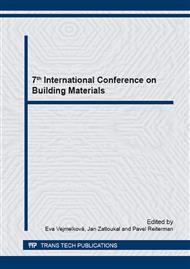[1]
R. Sovják, F. Vogel, B. Beckmann, 2013, Triaxial Compressive Strength of Ultra High Performance Concrete, Acta Polytechnica 53(6) (2013) 201-205.
DOI: 10.14311/ap.2013.53.0901
Google Scholar
[2]
F. Vogel, 2014, Production and Use of the Textile Reinforced Concrete, Advanced Materials Research, Vol. 982, pp.59-62.
DOI: 10.4028/www.scientific.net/amr.982.59
Google Scholar
[3]
R. Barhum, V. Mechtcherine, 2012, Effect of short, dispersed glass and carbon fibres on the behavior of textile-reinforced concrete under tensile loading, Engineering Fracture Mechanics, Vol. 92, pp.56-71.
DOI: 10.1016/j.engfracmech.2012.06.001
Google Scholar
[4]
J. Hartig, F. Jesse, K. Schicktanz, U. Häußler-Combe, 2012, Influence of experimental setups on the apparent uniaxial tensile load-bearing capacity of Textile Reinforced Concrete specimens, Materials and Structures, 45: 433-446. DOI 10. 1617/s11527-011-9775-0.
DOI: 10.1617/s11527-011-9775-0
Google Scholar
[5]
P., J. Mehta, P. Monteiro, Concrete: microstructure, properties, and materials. Fourth edition /. xxiii, 675 pages. ISBN 9780071797870.
Google Scholar
[6]
A. Brückner, R. Ortlepp, M. Curbach, 2006, Textile reinforced concrete for strengthening in bending and shear, Materials and Structures, 39: 741-784, DOI 10. 1617/s11527-005-9027-2.
DOI: 10.1617/s11527-005-9027-2
Google Scholar
[7]
R.A. van Vliet, G.M. van Mier, Experimental investigation of size effect in concrete and sandstone under uniaxial tension, Engineering Fracture Mechanics, Vol. 65, pp.165-188.
DOI: 10.1016/s0013-7944(99)00114-9
Google Scholar
[8]
E. Denneman, E. Kearsley, A. Visser, Splitting tensile test for fibre reinforced concrete, CSIR Built Environment, Meiring Naude Road, Pretoria, South Africa.
Google Scholar
[9]
B. Felekoglu, K. Tosun-Felekoglu, R. Ranade, Q. Zhang, V. Li, V., Influence of matrix flowability, fiber mixing procedure, and curing conditions on the mechanical performance of HTPP-ECC, Composites: Part B 60 (2014) 359-370.
DOI: 10.1016/j.compositesb.2013.12.076
Google Scholar
[10]
T. Vlach, L. Laiblová, A. Chira, M. Novotná, C. Fiala, M. Ženíšek, P. Hájek, 2014, Comparison of Different Methods for Determination of Modulus of Elasticity of Composite Reinforcement Produced from Roving, Advanced Materials Research, Vol. 1054, pp.104-109.
DOI: 10.4028/www.scientific.net/amr.1054.104
Google Scholar
[11]
F. Vogel, O. Holčapek, M. Jogl, K. Kolář, P. Konvalinka, 2015, Development of mechanical properties of steel fibers reinforced high strength concrete, Advanced Materials Research, Vol. 1077, pp.113-117.
DOI: 10.4028/www.scientific.net/amr.1077.113
Google Scholar
[12]
J. Koťátková, P. Reiterman, 2014, Effects of Different Types of Steel Fibers on the Mechanical Properties of High Strength Concrete, Advanced Materials Research, Vol. 1054, pp.80-84.
DOI: 10.4028/www.scientific.net/amr.1054.80
Google Scholar


